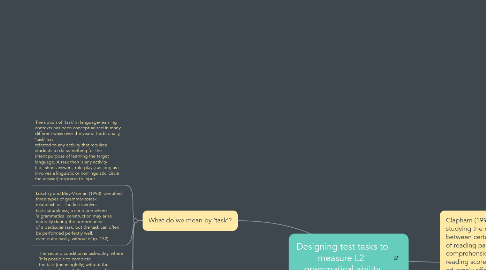Designing test tasks to measure L2 grammatical ability
by Nova Rica Duterte


1. What do we mean by ‘task’?
1.1. The notion of ‘task’ in language-learning contexts has been conceptualized in many different ways over the years. Traditionally, ‘task’ has referred to any activity that requires students to do something for the intent purpose of learning the target language. A task then is any activity (i.e., short answers, role-plays) as long as it involves a linguistic or nonlinguistic (circle the answer) response to input.
1.2. Loschky and Bley-Vroman (1993) identified three types of grammar-totask relationships. The first involves task-naturalness, a condition where ‘a grammatical construction may arise naturally during the performance of a particular task, but the task can often be performed perfectly well, even quite easily, without it’ (p. 132).
1.3. The second condition is task-utility, where ‘it is possible to complete the task [meaningfully] without the structure, but with the structure the task becomes easier’ (ibid.).
1.4. The final and most interesting condition for grammar assessment entails taskessentialness. This is where the task cannot be completed unless the grammatical form is used.
2. What are the characteristics of grammatical test tasks?
2.1. As the goal of grammar assessment is to provide as useful a measurement as possible of our students’ grammatical ability, we need to design test tasks in which the variability of our students’ scores is attributed to the differences in their grammatical ability, and not to uncontrolled or irrelevant variability resulting from the types of tasks or the quality of the tasks that we have put on our tests.
3. Clapham (1996) found that in studying the relationship between certain characteristics of reading passages and reading comprehension, the examinees’ reading scores were not adversely affected – as long as the passages did not present information that was overly specific to a particular subject area.
4. How does test development begin?
4.1. Those situations in which we use the target language to communicate in real life or in which we use it for instruction or testing are referred to as the target language use (TLU) situations (Bachman and Palmer, 1996).
4.1.1. Within these situations, the tasks or activities requiring language to achieve a communicative goal are called the target language use tasks.
4.1.1.1. A TLU task is one of many languageuse tasks that test-takers might encounter in the target language use domain. It is to this domain that language testers would like to make inferences about language ability, or more specifically, about grammatical ability
